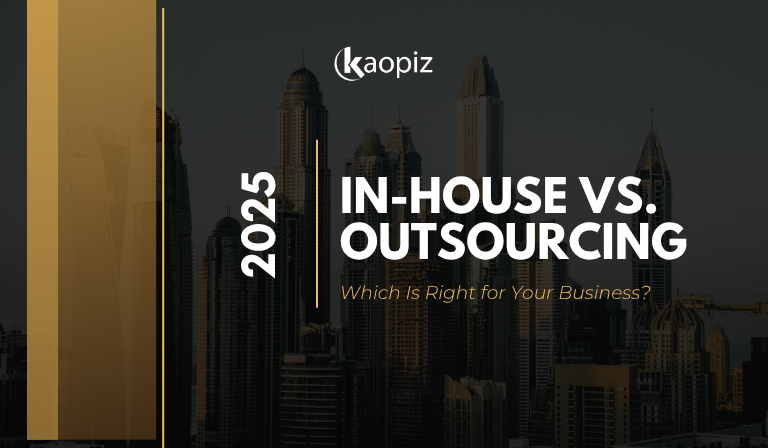Fitness App Development in 2025: Features, Costs & How to Build One
The global focus on health and wellness has never been stronger, and fitness apps are at the center of this movement. In 2025, the fitness app industry continues to grow rapidly, driven by rising user demand, AI-powered personalization, and seamless integration with wearable devices. Whether you’re a startup, gym owner, or enterprise looking to tap into this booming market, developing a fitness app offers tremendous opportunities.
In this blog, we’ll explore the key fitness apps overview, features, current development costs, and a step-by-step guide to bringing your fitness app idea to life. Let’s dive into what it takes to build a successful app.
Table of Contents
- Fitness App Industry Overview
- Types of Fitness Apps You Can Build
- Must-Have Features of a Modern Fitness App
- Fitness App Development Process
- How to Monetize a Fitness App?
- How Much Does It Cost to Build a Fitness App?
- Why Choose Kaopiz for Your Fitness App Project
- Conclusion
- FAQs
Fitness App Industry Overview
The fitness app industry is transforming, fueled by rising health awareness and demand for personalized digital wellness solutions. This section explores key market statistics and emerging trends shaping the future of fitness app development.
Key Fitness App Statistics
The global fitness app market continues to thrive in 2025, driven by growing health awareness and the increasing adoption of mobile-first solutions. According to Statista:
- Revenue in the Fitness Apps market is projected to reach $8.30 billion in 2025.
- It is expected to grow at a CAGR of 4.91% (2025–2029), reaching $10.06 billion by 2029.
- User penetration will rise from 12.21% in 2025 to 13.21% by 2029.
- The average revenue per user (ARPU) is projected at $20.79.
- The United States leads in revenue generation with an expected $2.49 billion in 2025.
To stand out in this competitive space, leading fitness app developers differentiate their platforms through innovation and specialized focus:
- MyFitnessPal: Specializes in calorie tracking and an extensive nutrition database, making it a go-to for diet-conscious users.
- Peloton: Delivers a competitive home workout experience through live-streamed classes and premium fitness hardware.
- Strava: Blends activity tracking with social networking, fostering a community-driven approach to fitness.
- Headspace: Focuses on mindfulness and mental well-being, offering guided meditations, sleep aids, and stress management tools.
- Kaopiz AI-Powered Fitness App: This custom fitness app development leverages AI for camera-based movement analysis, delivering real-time feedback and scoring. The platform integrates gamification features like quests, rankings, and virtual pets to boost motivation.
Emerging Fitness App Development Trends
As fitness apps become more sophisticated, new technologies are reshaping how users engage with health and wellness platforms. Here are the key trends driving innovation in fitness mobile app development:
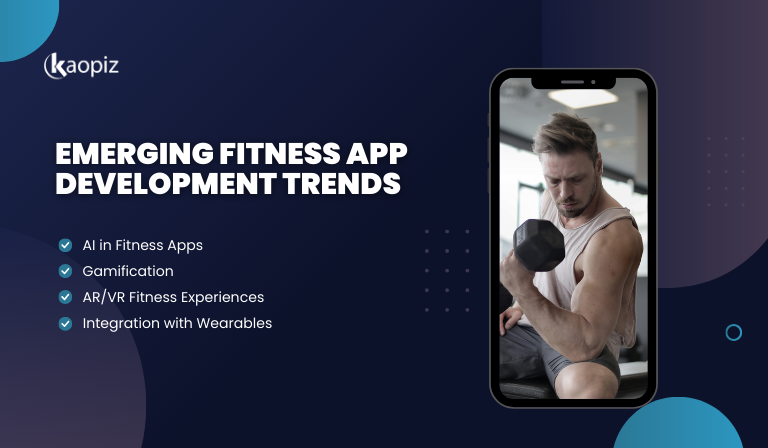
- AI in Fitness Apps: AI is transforming fitness apps with personalized workout suggestions, real-time form correction, and virtual coaching. These smart features adapt to each user’s goals and data, boosting engagement and results.
- Gamification: Gamification boosts fitness app engagement through challenges, badges, and leaderboards. These features make workouts fun, drive motivation, and help increase user retention.
- AR/VR Fitness Experiences: AR/VR in fitness apps creates immersive workouts—AR overlays real-world instructions, while VR offers interactive games and virtual classes, perfect for engaging at-home training.
- Integration with Wearables: Fitness apps now sync with wearables like Apple Watch and Fitbit, enabling real-time tracking of steps, heart rate, and sleep, improving data accuracy and overall health insights.
Types of Fitness Apps You Can Build
The fitness app ecosystem is diverse, catering to different health goals and user needs. Whether you’re targeting fitness enthusiasts, casual users, or gym businesses, choosing the right app type is essential to delivering value and standing out in the competitive market.
Here are the most popular types of fitness apps you can develop:
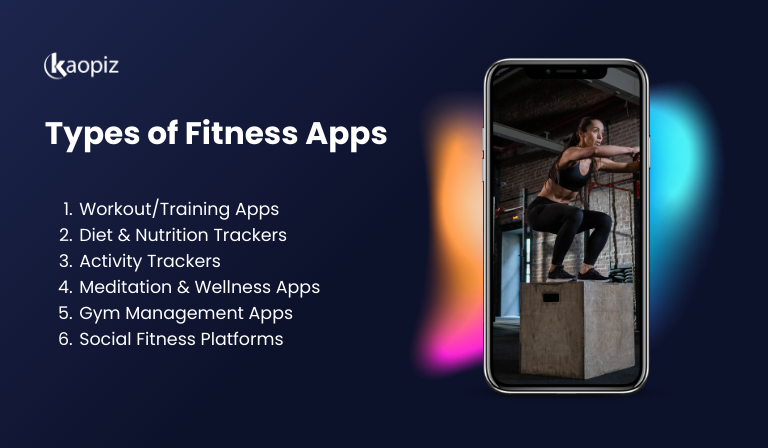
Workout/Training Apps
These apps offer structured workout programs, instructional videos, and progress tracking. Users can follow AI-generated personalized routines, set fitness goals, and receive performance insights. Ideal for home workouts or gym users, they often include features like rep counters, voice instructions, and exercise libraries.
Example features:
- Personalized training plans
- Real-time form correction
- Video-guided workouts
- Smart scheduling & reminders
Diet & Nutrition Trackers
Focused on healthy eating and weight management, these apps help users monitor calorie intake, log meals, and access vast nutrition databases. Often integrated with barcode scanners or meal suggestions, they’re a must-have for holistic health and fitness app development.
Example features:
- Calorie and macro tracking
- Custom meal plans
- Water intake reminders
- Food recognition via camera
Activity Trackers (with Wearables)
Activity trackers collect and analyze data from devices like Apple Watch, and other wearables. They provide insights on daily steps, heart rate, sleep quality, and more, helping users stay active and informed.
Example features:
- Real-time sync with wearables
- Step and distance tracking
- Sleep and heart rate monitoring
- Daily/weekly progress reports
Meditation & Wellness Apps
These apps cater to mental health and emotional well-being through guided meditations, breathing exercises, and stress management tools. A growing category, they’re often bundled with sleep support and mindfulness content.
Example features:
- Meditation and breathing guides
- Mood tracking
- Sleep stories and relaxation music
- Mindfulness challenges
Gym Management Apps
Designed for gym owners and personal trainers, these apps handle bookings, class schedules, member management, and in-app payments. A perfect solution for streamlining operations and enhancing client engagement.
Example features:
- Member registration and check-in
- Class scheduling and booking
- Trainer assignments
- Subscription and payment handling
Social Fitness Platforms
Apps like Strava have popularized the social side of fitness by enabling users to share workouts, join challenges, and compete on leaderboards. These platforms blend activity tracking with community-driven motivation.
Example features:
- Workout sharing and commenting
- Group challenges and events
- Leaderboards and achievement badges
- In-app messaging and social feeds
Must-Have Features of a Modern Fitness App
To build a successful health and fitness app, you need more than just great workouts or nutrition tips, you need a feature-rich, intuitive platform that keeps users engaged while allowing admins to manage and scale efficiently.

Below are the essential fitness app features should have:
User-Side Features
These features are designed to deliver a seamless and personalized experience that keeps users motivated and coming back for more:
- User onboarding & profile creation: A smooth onboarding flow allows users to quickly set up their fitness level, goals, and preferences, creating a tailored experience from the start.
- Goal setting & progress tracking: Let users set workout goals, track weight or steps, and monitor milestones with easy-to-read visual progress charts.
- Video tutorials & real-time guidance: High-quality instructional videos paired with voice or AI guidance enhance the user experience, ensuring workouts are performed safely and effectively.
- Wearable device integration: Seamless syncing with devices like Apple Watch, Fitbit, and Garmin enables real-time health tracking, such as heart rate, calories burned, and sleep metrics.
- AI-powered suggestions: Machine learning enables the app to recommend workouts, adjust difficulty levels, and offer recovery advice based on user behavior and progress.
- Notifications & reminders: Push notifications help users stay consistent by reminding them of workouts, hydration, or meditation sessions.
- Community or social sharing: Social features like group challenges, leaderboards, and workout sharing foster a sense of accountability and friendly competition, key for boosting retention.
Admin-Side Features
Behind every great fitness app is a powerful backend system that empowers admins to manage users, content, and revenue efficiently:
- User management: Admins can view, edit, or remove user accounts, monitor activity levels, and manage support requests.
- Content management: From workout videos to nutrition plans, the admin panel should offer easy uploading, editing, and organizing of content.
- Analytics dashboard: Track app performance, user behavior, retention rates, and revenue metrics to make informed decisions and improvements.
- Subscription/payment control: Integrate and manage one-time purchases, freemium plans, and monthly subscriptions with ease. Include billing history and refund management.
- Feedback & support management: Collect user feedback, manage support tickets, and gain insights into user pain points to enhance app satisfaction.
Fitness App Development Process
Building a successful fitness app requires a systematic and strategic approach, from validating the concept to post-launch support. Whether you’re developing a workout tracker, nutrition planner, or social fitness platform, following a well-defined process ensures product quality, user satisfaction, and long-term growth.
Here’s a step-by-step breakdown of the process on how to develop a fitness app:
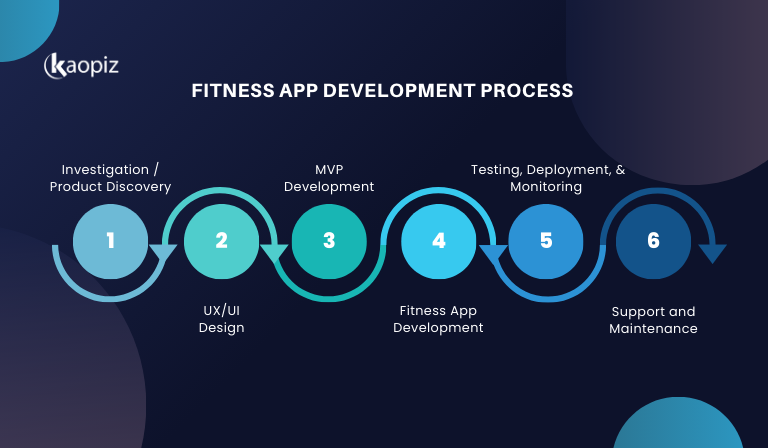
Step 1: Investigation / Product Discovery
A strong foundation starts with understanding the market and your users.
- Market Research: Analyze fitness app trends, study competitors, and uncover unmet user needs to identify opportunities in the health and fitness app development space.
- Target Audience Definition: Define demographics, goals, and pain points of your potential users—whether they’re gym-goers, home fitness fans, or wellness seekers.
- Goal Setting: Set clear business objectives and measurable KPIs to guide the entire development lifecycle.
Step 2: UX/UI Design
Design plays a critical role in user adoption and retention.
- Prototyping and User Flow: Create wireframes to map out app screens, features, and navigation paths.
- UX Customization: Build a seamless and intuitive user experience, tailored for ease of use and visual appeal.
- Fitness Mobile App Design: Ensure accessibility, responsive layouts, and motivational visual elements that align with user goals.
Step 3: MVP Development
Launch faster and validate your idea with a Minimum Viable Product (MVP).
- Define Core Features: Focus on essentials like user profiles, activity tracking, workout plans, and notifications.
- Iterative Development: Build quickly, test early, and refine continuously based on user feedback.
Step 4: Full-Scale Fitness App Development
Develop fitness app with high performance and scalability in mind.
- Front-End Development: Create interactive and responsive interfaces using modern frameworks like Flutter or React Native for cross-platform support.
- Back-End Development: Build a secure and scalable system for data storage, authentication, and server-side logic.
- Third-Party Integrations: Incorporate APIs for payment gateways, wearable devices, AI engines, and social media sharing to enhance functionality.
Step 5: App Testing, Deployment, and Monitoring
Quality assurance and analytics ensure your app is ready for the real world.
- App Testing: Conduct thorough functional, usability, security, and device compatibility testing.
- Deployment: Publish on the App Store and Google Play, with optimized App Store Optimization (ASO) strategies for better discoverability.
- Performance Monitoring: Use tools like Firebase, Mixpanel, or Google Analytics to track crashes, user behavior, and retention rates.
Step 6: Ongoing Support and Maintenance
Post-launch is where long-term success is built.
- Regular Updates: Fix bugs, optimize performance, and release new features in response to user feedback.
- Compatibility & Scalability: Ensure the app stays up to date with OS changes and is ready to scale as your user base grows.
- Future Planning: Stay competitive by planning feature expansions like AI coaching, gamification, or AR/VR integration.
How to Monetize a Fitness App?
Building a fitness app isn’t just about helping users reach their health goals—it’s also a strategic opportunity to generate revenue. The key is choosing the right monetization model that aligns with your target audience, app type, and long-term business goals.
Here is a brief table about the most effective ways to monetize a fitness app in 2025:
| Monetization Strategy | Description | Example |
|---|---|---|
| Freemium Model | Offer core features for free, with premium upgrades for advanced tools. | MyFitnessPal – basic logging is free; premium offers insights. |
| Subscription Plans | Charge recurring fees (monthly/yearly) for full access to features and content. | Fitbit Premium – subscription for guided programs and insights. |
| In-App Purchases | Sell one-off items like custom workouts, nutrition plans, or gamified rewards. | 7 Minute Workout – users buy premium workout packs. |
| Advertisements | Show banner or video ads to free users; earn via impressions or clicks. | Daily Yoga – uses ads between session content. |
| Affiliate Marketing / Partnerships | Promote third-party products or services and earn a commission. | Strava – partners with brands like Lululemon or WHOOP. |
| Paid App (One-Time Purchase) | Users pay once to download and use the app with no recurring charges. | Streaks – task-based fitness app with a flat fee. |
| White-Labeling / Licensing | License your app as a customizable platform to gyms, trainers, or wellness brands. | Custom-branded versions offered by Kaopiz to fitness businesses. |
Many successful fitness apps combine multiple monetization models—like freemium + in-app purchases or subscriptions + brand partnerships—to maximize revenue and flexibility.
How Much Does It Cost to Build a Fitness App?
One of the most common questions businesses and startups ask when planning a fitness app is: “What’s the development cost?” The fitness app development cost can range from $30,000 to $300,000+, depending on your goals and approach.
While there’s no one-size-fits-all answer, understanding the key factors that influence pricing can help you plan your budget and choose the right approach.
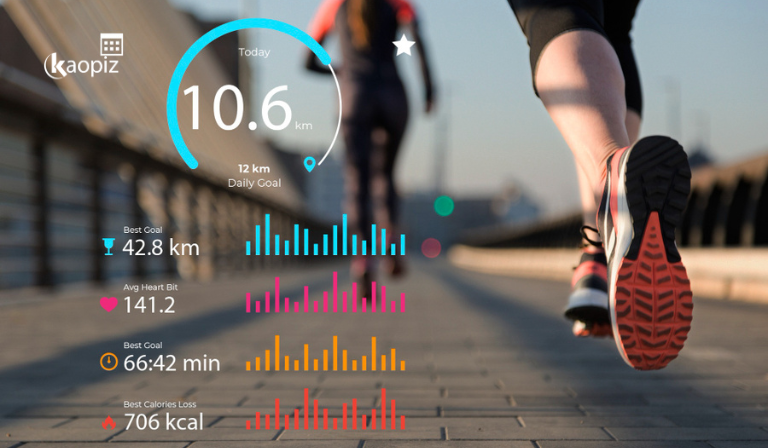
UI/UX Design and App Complexity
A good design keeps users engaged, but design costs vary based on quality.
- Basic UI/UX design: $10,000 – $20,000
- Advanced design with custom graphics and animations: $50,000+
App complexity also plays a major role:
- Simple apps with basic features cost around $30,000 – $50,000
- Advanced apps with real-time tracking or third-party integrations can cost $100,000 – $300,000
Feature Selection
The features you choose are one of the biggest cost drivers.
- A basic fitness app (tracking, goals, login) typically costs $30,000 – $50,000
- Adding features like AI-based suggestions, wearable integrations, or virtual coaches will significantly increase costs.
Also, building for both iOS and Android separately adds cost, but using cross-platform frameworks like Flutter or React Native can reduce that cost.
Prototyping and Regulatory Compliance
Before full development, building a prototype is essential for testing or pitching to investors.
- Basic prototypes: $5,000 – $15,000
- Advanced prototypes will cost more depending on interactions and fidelity.
If your app handles user health data, compliance with GDPR or HIPAA is crucial. This adds $10,000 – $20,000 to cover data security, encryption, and authentication features.
AI and Virtual Coaches
Adding AI-powered virtual coaching (e.g., movement detection, personalized feedback) is powerful but expensive.
- Estimated cost: $50,000 – $100,000, depending on the complexity of machine learning models.
- If you offer subscription plans, payment gateway integrations will cost around $5,000 – $15,000, depending on the number of tiers and platforms.
Development Team Location
Where your team is based impacts your total budget.
- Developers in North America or Western Europe charge $100 – $250/hour
- Eastern Europe, India, or Southeast Asia: $30 – $100/hour
- Vietnam offers a cost-effective range of $25 – $50/hour, with many skilled developers experienced in fitness app projects.
Budget Management Tip: Start with an MVP
To reduce risk and manage costs, start with an MVP that includes only core features. This helps you test your app, get real user feedback, and decide which features to invest in next, without spending everything upfront.
Why Choose Kaopiz for Your Fitness App Project
Choosing the right fitness app development company is critical to the success of your app. At Kaopiz, we combine technical excellence, industry experience, and a client-first approach to deliver powerful, scalable fitness solutions tailored to your business goals.
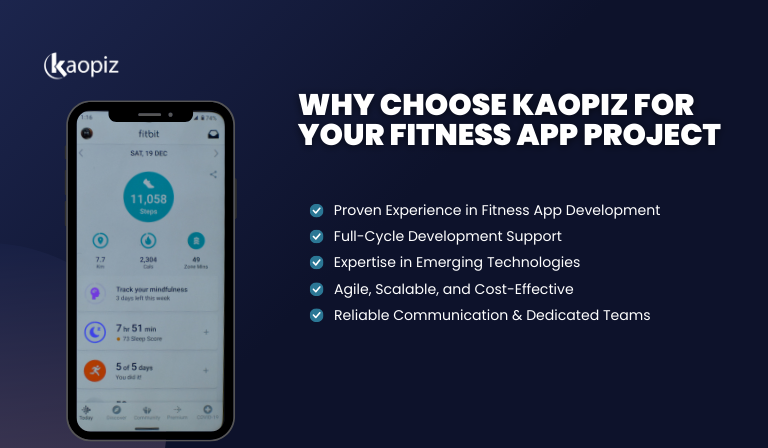
- Proven Experience in Fitness App Development: We’ve successfully developed custom fitness apps that include AI-powered movement analysis, gamification features, and wearable device integration—trusted by real users and businesses.
- Full-Cycle Development Support: From idea validation and prototyping to development, launch, and maintenance—we support you at every stage for building a workout app, nutrition tracker, or gym management platform successfully.
- Expertise in Emerging Technologies: Our team specializes in technologies that are transforming the fitness industry, such as AI/ML, BLE and IoT integration, AR/VR and gamification, and Cross-platform frameworks like Flutter and React Native.
- Agile, Scalable, and Cost-Effective: With over 300 engineers and an agile development approach, Kaopiz delivers high-quality apps on time and within budget. Based in Vietnam, we offer top-quality development at competitive rates.
- Reliable Communication & Dedicated Teams: We provide clear communication, flexible engagement models, and dedicated development teams aligned with your vision.
Whether you’re launching your first fitness app or scaling an existing platform, Kaopiz brings the expertise, speed, and strategic mindset needed to bring your product to life—and to market.
Conclusion
The fitness app market in 2025 presents a powerful opportunity for businesses to tap into the growing demand for health and wellness solutions. With the right features, monetization model, and technology stack, you can build an app that not only meets user needs but also drives long-term engagement and revenue.
Whether you’re starting with an MVP or aiming for a fully featured platform, success lies in a clear strategy, user-centric design, and a reliable development partner. At Kaopiz, we combine deep technical expertise with industry experience to bring great fitness app development services efficiently and cost-effectively.
Ready to build the next big thing in fitness tech? Let’s talk.
FAQs
Can You Help Me Turn My Fitness App Idea into a Working Product, Even If I Don’t Have Technical Experience?
Absolutely. At Kaopiz, we guide you through every step—from idea validation and feature planning to development and launch. You don’t need a technical background—we translate your vision into a functional, scalable app.
Why Should I Choose a Development Partner Instead of Hiring My Own In-house Team?
Hiring and managing an in-house team takes time, resources, and long-term commitment. Partnering with a dedicated development company like Kaopiz gives you immediate access to experienced professionals, proven processes, and faster time to market, often at a lower cost.
How Long Does It Take to Develop a Fitness App?
It depends on the complexity and features. A basic MVP typically takes 2–3 months, while a full-featured fitness app can take 4–6 months or more. We work with you to set clear timelines and deliver in agile, iterative stages.
Trending Post

